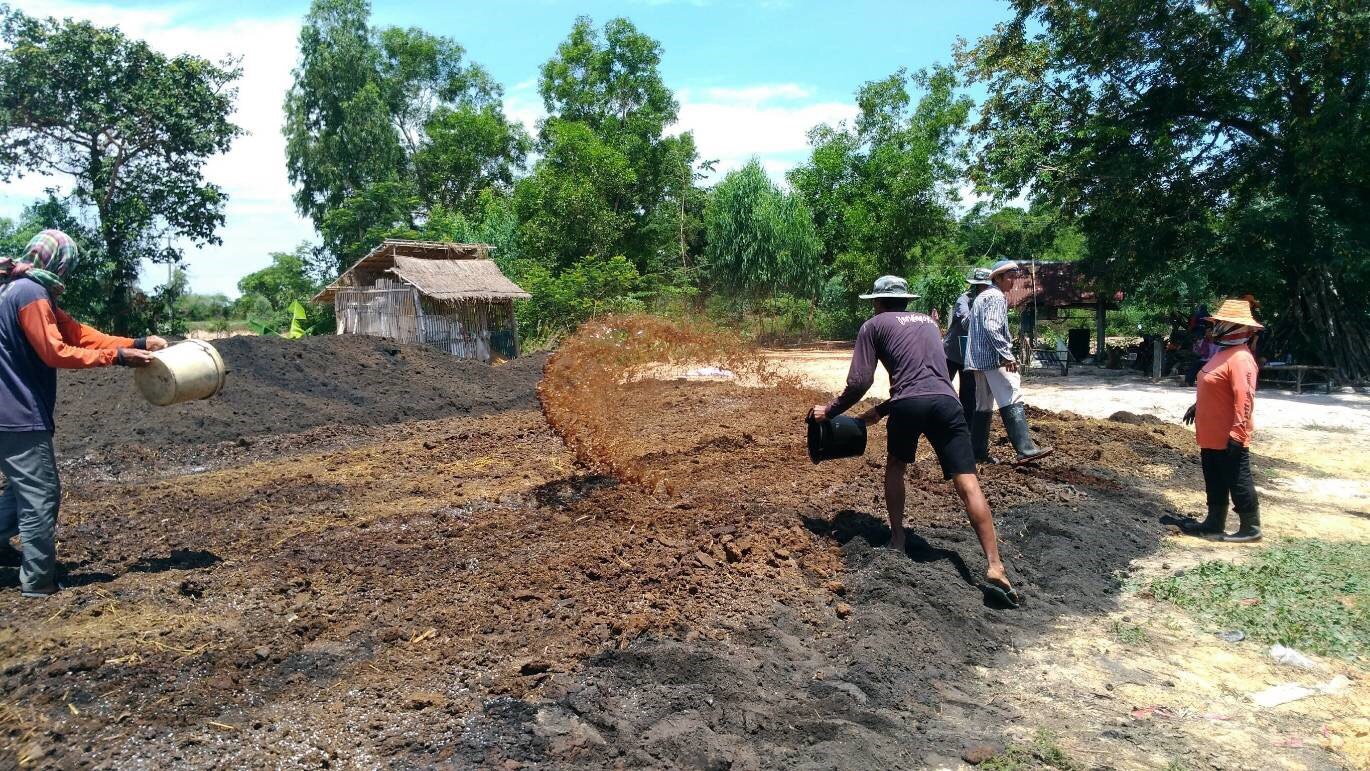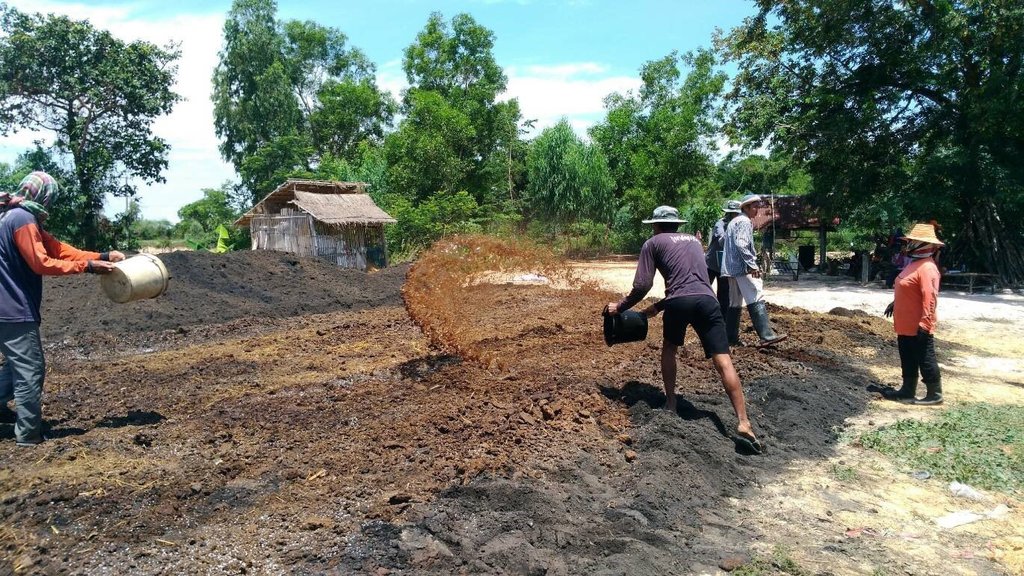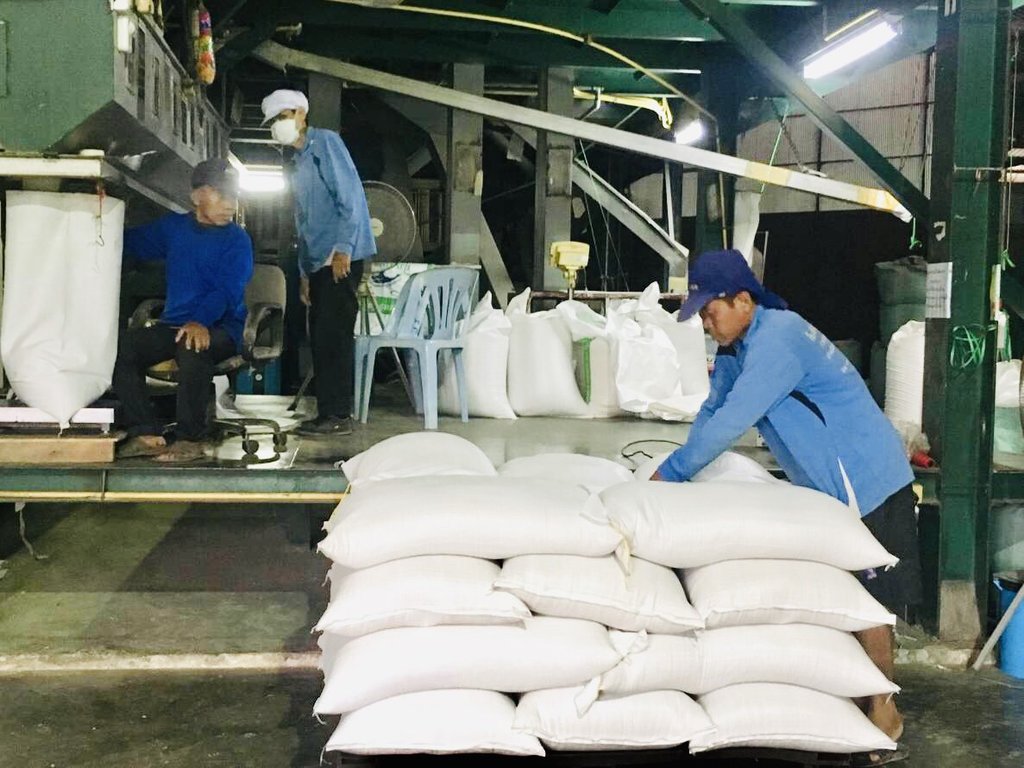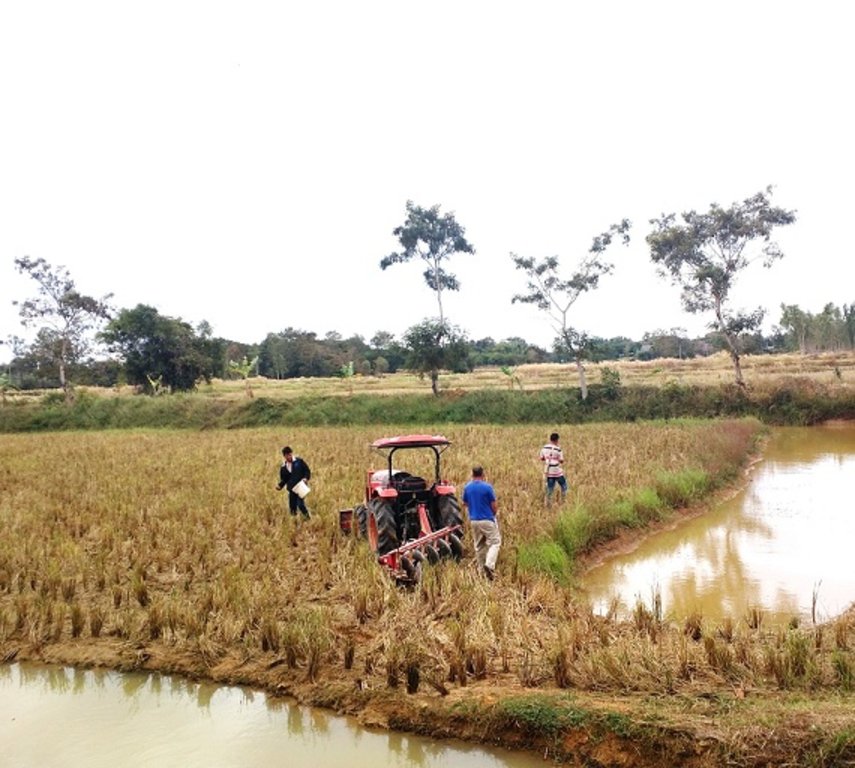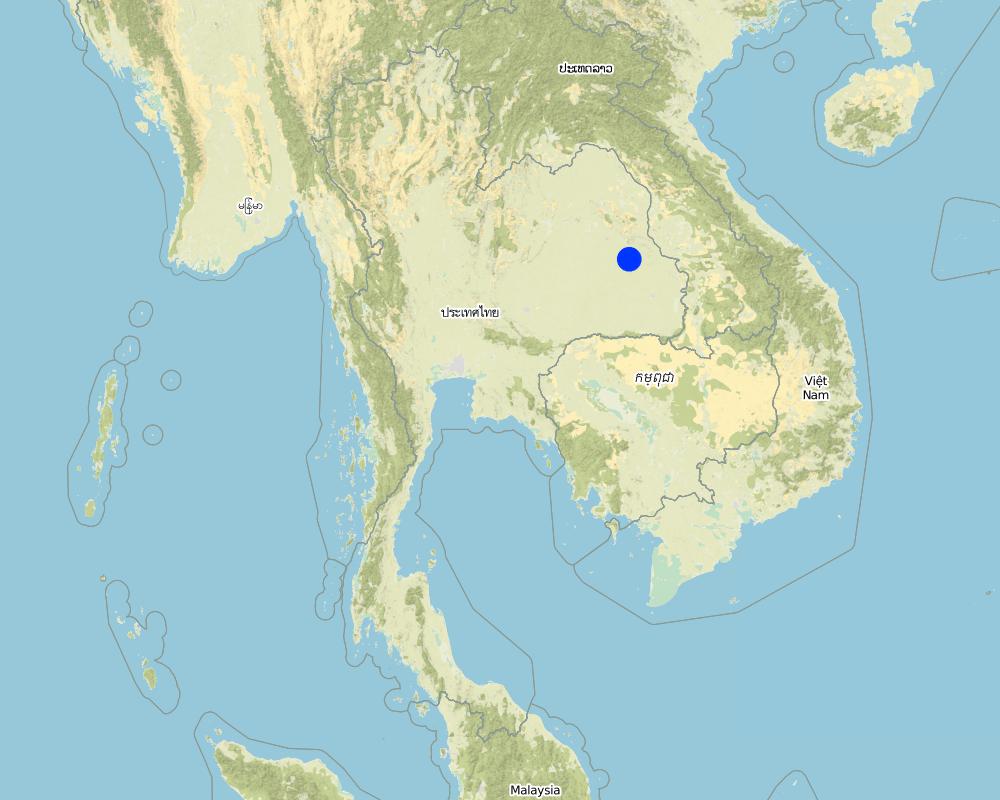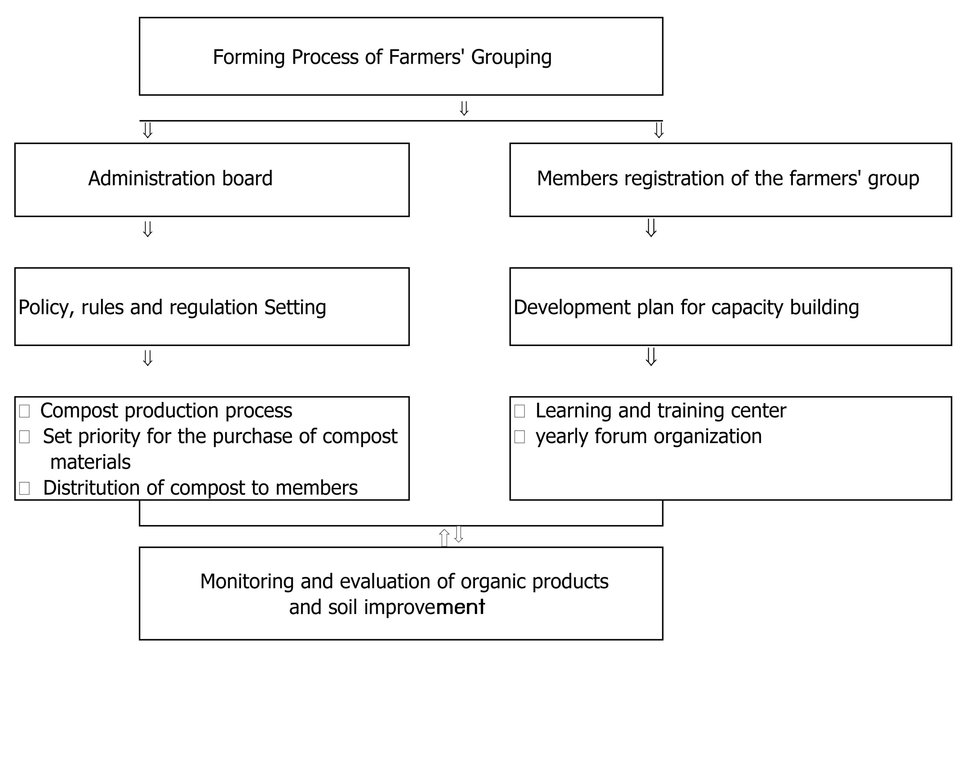Strengthening Farmers' Self-grouping Participation in Organic Rice Production [ໄທ]
- ການສ້າງ:
- ປັບປູງ:
- ຜູ້ສັງລວມຂໍ້ມູນ: Yuthasong Namsai
- ບັນນາທິການ: –
- ຜູ້ທົບທວນຄືນ: Rima Mekdaschi Studer, Samran Sombatpanit, Alexandra Gavilano
approaches_4201 - ໄທ
ເບິ່ງພາກສ່ວນ
ຂະຫຍາຍທັງໝົດ ຍຸບທັງໝົດ1. ຂໍ້ມູນທົ່ວໄປ
1.2 ລາຍລະອຽດ ການຕິດຕໍ່ ຂອງບຸກຄົນທີ່ຊັບພະຍາກອນ ແລະ ສະຖາບັນ ການມີສ່ວນຮ່ວມ ໃນການປະເມີນຜົນ ແລະ ເອກະສານ ຂອງວິທີທາງ
ບຸກຄົນສຳຄັນ (ຫຼາຍຄົນ)
ຜູ້ນໍາໃຊ້ທີ່ດິນ:
Samsee Mun
Rak Thammachat Club (Naso Rice Farmer Group)
Ban Sok, Naso Sub-district, Kutchum District, Yasothon Province 35140
ໄທ
ຜູ້ນໍາໃຊ້ທີ່ດິນ:
Kaewsai Pongmarin
+66-81-2383883
Rak Thammachat Club (Naso Rice Farmer Group)
45 Moo 4, Ban Pawai, Naso Sub-district, Kutchum District, Yasothon Province
ໄທ
ຜູ້ນໍາໃຊ້ທີ່ດິນ:
Polchai Moon
Rak Thammachat Club (Naso Rice Farmer Group)
66 Moo 2, Ban Sokkumpoon, Naso Sub-district, Kutchum District, Yasothon Province
ໄທ
ຜູ້ນໍາໃຊ້ທີ່ດິນ:
Thongnoi Kumfong
Rak Thammachat Club (Naso Rice Farmer Group)
40 Moo 2, Ban Sokkumpoon, Naso Sub-district, Kutchum District, Yasothon Province
ໄທ
ຜູ້ຊ່ຽວຊານ ດ້ານການຄຸ້ມຄອງ ທີ່ດິນແບບຍືນຍົງ:
Namsai Yutthasong
Yuthasong2559@gmail.com
Land Development Office Region 4
ຜູ້ຊ່ຽວຊານ ດ້ານການຄຸ້ມຄອງ ທີ່ດິນແບບຍືນຍົງ:
Sangkeaw Kanyaporn
Kanyaporn8488@gmail.com
Land Development Office Region 4
ຜູ້ຊ່ຽວຊານ ດ້ານການຄຸ້ມຄອງ ທີ່ດິນແບບຍືນຍົງ:
Hansugjaijareon Kanokwan
Kanokwanhans@gmail.com
Land Development Office Region 4
ຜູ້ຊ່ຽວຊານ ດ້ານການຄຸ້ມຄອງ ທີ່ດິນແບບຍືນຍົງ:
Kaoya Putchanee
putchanee99@gmail.com
Land Development Office Region 4
ໄທ
national consultant:
Arunin Somsri
ssarunin@gmail.com
Land Development Department
ໄທ
ຊື່ຂອງໂຄງການ ທີ່ອໍານວຍຄວາມສະດວກ ໃນການສ້າງເອກກະສານ ຫຼື ປະເມີນດ້ານແນວທາງ (ຖ້າກ່ຽວຂ້ອງ)
Decision Support for Mainstreaming and Scaling out Sustainable Land Management (GEF-FAO / DS-SLM)ຊື່ຂອງ ສະຖາບັນການຈັດຕັ້ງ ທີ່ອໍານວຍຄວາມສະດວກ ໃນການສ້າງເອກກະສານ ຫຼື ປະເມີນແນວທາງ (ຖ້າກ່ຽວຂ້ອງ)
Land Development Department LDD (Land Development Department LDD) - ໄທ1.3 ເງື່ອນໄຂ ຂອງການນໍາໃຊ້ເອກກະສານຂໍ້ມູນ ຂອງ WOCAT
ຜູ້ສັງລວມ ແລະ ບັນດາຜູ້ຕອບແບບສອບຖາມ ຍອມຮັບໃນເງື່ອນໄຂ ການນໍາໃຊ້ຂໍ້ມູນເອກະສານ ທີ່ສ້າງຂື້ນ ໂດຍຜ່ານ ອົງການ WOCAT:
ແມ່ນ
1.4 ເອກະສານອ້າງອີງ (ຫຼາຍ) ກັບແບບສອບຖາມ (ຫຼາຍ) ເຕັກໂນໂລຢີ ຂອງດ້ານການຄຸ້ມຄອງ ດິນແບບຍືນຍົງ
2. ພັນລະນາ ແນວທາງການຄຸ້ມຄອງນໍາໃຊ້ດິນແບບຍືນຍົງ
2.1 ການອະທິບາຍ ໂດຍຫຍໍ້ ຂອງວິທີທາງ
A group of 253 farmers had participated in organic rice production covering an area of 6,000 rai at Ban Naso, Naso Sub-district, Kutchum District, Yasothon Province since 1989 by using organic fertilizers (compost). The produced organic rice has been certified since 1989 as meeting the standard by OACT and IFOAM; it has been exported more than 3,000 tons/yr.
2.2 ການອະທິບາຍ ລາຍລະອຽດ ຂອງວິທີທາງ
ການອະທິບາຍ ລາຍລະອຽດ ຂອງວິທີທາງ:
The distinctive character of this farmer group is the integration for producing organic crops by using organic fertilizers from agricultural by-products and residues from organic-fermented liquid kitchen wastes and green manure. The group of farmers has been successfully supported by private and public organizations. The main objectives are to produce organic rice for export for higher income, with the aim at better health of farmers and consumers for having been saved from agricultural chemical residues. The concept of organic rice production has been the use of organic fertilizers by farmers participation. The establishment of learning and training center has been an important tool to scale up and scale out the activities; the certification of the products has been necessary to promote the export. The stages of implementation have been as follows: (1) formulate and prioritize policy and plan by the committee of 20 farmers from the group; (2) organize meetings for the 253 farmer members to determine rice varieties and after-rice vegetables; (3) purchase raw materials for making compost by 3 sources of funds: a. from the group by selling compost to non-members; b. the private export companies pay a premium of approx. 300,000 THB/yr to the group; and c. the government agencies support the materials for learning and training. The model of using organic fertilizers to produce organic crops is scaling out to 33 farmer groups in various districts of Yasothon Province. The main crop production has been the organic rice, which is collected at the center for export. The implementation includes crop planting, maintenance, harvest, certification, and selling. The stakeholders’ responsibilities are: 253 farmers in the group produce and sell their own products in the green markets, restaurants and hospitals, while private companies purchase the rice for export. The concerned government agencies are listed as: the Land Development Department provides the knowledge of making compost and organic-fermented liquid and also distributes green manure seeds and activators of bacteria and fungi for compost fermentation. Department of Agricultural Extension provides funding in establishing the learning and training center and materials used for training. Agricultural Cooperatives Promotion Department supports the knowledge of household accounting. Department of Groundwater provides groundwater irrigation by drilling holes 30-40 m deep. Department of Alternative Energy Development and Efficiency provides solar cells as the source of energy. Some private organizations such as OACT and IFOAM etc. certify the organic food products. The farmer groups have been fully satisfied of the quality of their rice products that well serve the market demand and they get higher income as a result. Farmers are healthier and are safe from agricultural chemical residues; all of them are proud of their high quality rice products to export.
2.3 ຮູບພາບຂອງແນວທາງ
2.4 ວີດີໂອ ຂອງວິທີທາງ
2.5 ປະເທດ / ເຂດ / ສະຖານທີ່ບ່ອນທີ່ແນວທາງໄດ້ຖືກນໍາໃຊ້
ປະເທດ:
ໄທ
ພາກພື້ນ / ລັດ / ແຂວງ:
Yasothon
ຂໍ້ມູນເພີ່ມເຕີມຂອງສະຖານທີ່:
Ban Naso, Naso Sub-district, Kutchum District, Yasothon Province, Thailand
ຄວາມຄິດເຫັນ:
Each member’s field has similar physical characteristics and large area, suitable for the application of technologies. Therefore, they are convenient to apply the Technology in the area.
Map
×2.6 ວັນທີເລີ່ມຕົ້ນ ແລະ ສິ້ນສຸດ ການຈັດຕັ້ງປະຕີບັດ ວິທີທາງ
ສະແດງປີຂອງການເລີ່ມຕົ້ນ:
1989
ຖ້າຫາກບໍ່ຮູ້ຈັກປີທີ່ແນ່ນອນ, ໃຫ້ປະມານຄາດຄະເນ ເອົາມື້ທີ່ໄດ້ເລີ່ມຈັດຕັ້ງປະຕິບັດ ວິທີທາງ:
10-50 ປີ ຜ່ານມາ
ຄວາມຄິດເຫັນ:
These concepts are still continuously proceeded because all over the world emphasizes public health and food safety.
2.7 ປະເພດຂອງແນວທາງ
- ພື້ນເມືອງ / ທ້ອງຖີ່ນ
2.8 ເປົ້າໝາຍ / ຈຸດປະສົງຫຼັກ ຂອງການຈັດຕັ້ງປະຕິບັດ ວິທີທາງ
1) To promote the use of organic fertilizers to produce rice and other crops.
2) To promote the production system for higher income.
3) To promote the gathering of farmers as a group that will improve communities in the form of being self-reliant.
2.9 ເງື່ອນໄຂອໍານວຍ ຫຼື ຂັດຂວາງການປະຕິບັດຂອງເຕັກໂນໂລຢີ / ເຕັກໂນໂລຢີການນໍາໃຊ້ຕາມແນວທາງ
ສັງຄົມ / ວັດທະນະທໍາ / ມາດຕະຖານ ແລະ ຄຸນຄ່າທາງສາສະໜາ
- ອໍານວຍ
Being a society of organic agriculture lifestyle.
ມີຄວາມສາມາດ / ເຂັ້າເຖິງຊັບພະຍາກອນດ້ານການເງິນ ແລະ ການບໍລິການ
- ອໍານວຍ
Farmer groups can support themselves since the leaders are strong so that the financial agencies trust and are ready to support.
ການກໍ່ຕັ້ງສະຖາບັນ
- ອໍານວຍ
Both government and private agencies support the marketing aspect, production inputs, production designs and knowledge transfer.
ການຮ່ວມມື / ການປະສານງານຂອງຜູ້ກ່ຽວຂ້ອງ
- ອໍານວຍ
The collaboration and coordination among concerned agencies continuously occur.
ກ່ຽວກັບກົດໝາຍ (ສິດນໍາໃຊ້ດິນ, ສິດນໍາໃຊ້ນໍ້າ)
- ອໍານວຍ
Farmers have legal rights on their lands as title deed, so they get motivation to develop and maintain their land sustainably.
ນະໂຍບາຍ
- ອໍານວຍ
The government policies promote the organic agriculture.
ການປົກຄອງທີ່ດິນ (ການຕັດສິນໃຈ, ການປະຕິບັດ ແລະ ຂໍ້ບັງຄັບ)
- ອໍານວຍ
Their lands are categorized as highly suitable for rice planting.
ຄວາມຮູ້ກ່ຽວກັບການຄຸ້ມຄອງ ທີ່ດິນແບບຍືນຍົງ, ການເຂົ້າເຖິງການສະໜັບສະໜູນ ທາງດ້ານວິຊາການ
- ອໍານວຍ
Land Development Department supports the knowledge and organic fertilizer inputs.
ຕະຫຼາດ (ໃນການຊື້ວັດຖຸດິບ, ຂາຍຜະລິດຕະພັນ) ແລະ ລາຄາ
- ອໍານວຍ
1) The Green Net Company has been buying the whole rice yield for packaging.
2) The provincial commerce agencies support the public relations, budget for showrooms and markets.
ວຽກ, ມີກໍາລັງຄົນ
- ອໍານວຍ
The mill labourers get the dividend.
ອື່ນໆ
- ອໍານວຍ
The added values of production are created by making the groups’ trademarks.
- ເຊື່ອງຊ້ອນ
The consumer markets fluctuated.
3. ການມີສ່ວນຮ່ວມ ແລະ ບົດບາດຂອງພາກສ່ວນທີ່ກ່ຽວຂ້ອງທີ່ໄດ້ມີສ່ວນຮ່ວມ
3.1 ຜູ້ມີສ່ວນຮ່ວມ ໃນວິທີທາງ ແລະ ພາລະບົດບາດ ຂອງເຂົາເຈົ້າ
- ຜູ້ນໍາໃຊ້ດິນໃນທ້ອງຖິ່ນ / ຊຸມຊົນທ້ອງຖິ່ນ
Members of farmers groups
Produce organic crop
- ອົງການຈັດຕັ້ງ ພາຍໃນຊຸມຊົນ
Naso Sub-district Administration Organization
Public relations
- ຜູ້ຊ່ຽວຊານ ການນຄຸ້ມຄອງ ທີ່ດິນແບບຍືນຍົງ / ທີ່ປຶກສາດ້ານກະສິກໍາ
Mr. Piyamit Phukongnum, Agricultural Officer
Training
- ນັກຄົ້ນຄວ້າ
Researchers from the Government's research agencies
Training
- ຄູອາຈານ / ນັກຮຽນ / ນັກສຶກສາ
University students
Farm visit
- ອົງການຈັດຕັ້ງ ທີ່ບໍ່ຂື້ນກັບລັດຖະບານ
Green Net Organic Company
Purchase products
- ພາກເອກະຊົນ
Green markets, food stores, restaurants and modern trade stores
Provide market
3.2 ການມີສ່ວນຮ່ວມຂອງຜູ້ນໍາໃຊ້ທີ່ດິນໃນທ້ອງຖິ່ນ / ຊຸມຊົນທ້ອງຖິ່ນໃນໄລຍະທີ່ແຕກຕ່າງກັນຂອງແນວທາງ
| ການລວບລວມ ເອົາຜູ້ນໍາໃຊ້ດິນ ໃນທ້ອງຖິ່ນ / ຊຸມຊົນທ້ອງຖິ່ນ | ໃຫ້ລະບຸ ຜູ້ໃດທີ່ມີສ່ວນຮ່ວມ ໃນແຕ່ລະກິດຈະກໍາ? | |
|---|---|---|
| ການເລີ່ມຕົ້ນ / ແຮງຈູງໃຈ | ການນໍາໃໍຊ້ເອງ | The foreigners by the group chairman (Mr. Mun Samsee)'s suggestion recommended the process of non-chemical agriculture. |
| ການວາງແຜນ | ການນໍາໃໍຊ້ເອງ | The chairman and members collaborate to plan the organic fertilizer production. |
| ການປະຕິບັດ | ການນໍາໃໍຊ້ເອງ | The chairman and members produce organic fertilizers together. |
| ຕິດຕາມກວດກາ / ການປະເມີນຜົນ | ການຮ່ວມມື | The private company (Thai export company) monitored the quality of organic rice with emphasis on the preservation of the environment and the sustainability of the program. |
3.3 ແຜນວາດ (ຖ້າມີ)
ການອະທິບາຍ:
Flow chart shows the implementation of the approach.
ຜູ້ຂຽນ:
Miss Kanokwan Hansugjaijareon
3.4 ການຕັດສິນໃຈກ່ຽວກັບການຄັດເລືອກເຕັກໂນໂລຢີຂອງການຄຸ້ມຄອງທີ່ດິນແບບຍືນຍົງ / ເຕັກໂນໂລຢີ
ລະບຸ ຄົນທີ່ຕັດສິນໃຈ ກ່ຽວກັບການຄັດເລືອກຂອງ ເຕັກໂນໂລຢີ / ເຕັກໂນໂລຢີ ຈະໄດ້ຮັບການປະຕິບັດ:
- ຜູ້ນໍາໃຊ້ທີ່ດິນຫຼັກ, ການສະໜັບສະໜູນ ໂດຍຜູ້ຊ່ຽວຊານ ການນໍາໃຊ້ທີ່ດິນແບບຍືນຍົງ
4. ການສະໜັບສະໜູນທາງດ້ານວິຊາການ, ການສ້າງຄວາມສາມາດ, ແລະ ການຈັດການຄວາມຮູ້.
4.1 ການສ້າງຄວາມສາມາດ / ການຝຶກອົບຮົມ
ຜູ້ນໍາໃຊ້ທີ່ດິນ ຫຼື ພາກສ່ວນກ່ຽວຂ້ອງອື່ນໆ ໄດ້ຮັບການຝຶກອົບຮົມບໍ່?
ແມ່ນ
ໃຫ້ລະບຸ ຜູ້ໃດທີ່ໄດ້ຮັບການຝຶກອົບຮົມ:
- ຜູ້ນໍາໃຊ້ດິນ
ຖ້າເປັນໄປໄດ້, ໃຫ້ລະບຸເພດ, ອາຍຸ, ສະຖານະພາບ, ຊົນເຜົ່າ, ແລະ ອື່ນໆ:
Farmers in Naso Sub-district and nearby
ຮູບແບບຂອງການຝຶກອົບຮົມ:
- ການເຮັດຕົວຈິງ
- ຕົວຕໍ່ຕົວ
ໃນຫົວຂໍ້:
The creation of organic agriculture network, the markets for export, livestock, etc.
ຄວາມຄິດເຫັນ:
Most of the members have agriculture knowledge rather well, so it is easy to expand the concepts and market.
4.2 ການບໍລິການໃຫ້ຄໍາປຶກສາ
ເຮັດຜູ້ໃຊ້ທີ່ດິນມີການເຂົ້າເຖິງການບໍລິການໃຫ້ຄໍາປຶກສາ?
ແມ່ນ
ລະບຸວ່າການສະໜອງ ການບໍລິການ ໃຫ້ຄໍາປຶກສາ:
- ສູນຄົ້ນຄວ້າ
ອະທິບາຍ / ຄວາມຄິດເຫັນ:
The Ministry of Agriculture and Cooperatives officers recommend and support the knowledge and production inputs.
4.3 ສະຖາບັນການສ້າງຄວາມເຂັ້ມແຂງ (ການພັດທະນາອົງການຈັດຕັ້ງ)
ສະຖາບັນ ໄດ້ຮັບການສ້າງຕັ້ງຂື້ນ ຫຼື ໄດ້ຮັບການສ້າງຄວາມເຂັ້ມແຂງ ໂດຍການຈັດຕັ້ງປະຕິບັດ ວິທີທາງບໍ່?
- ບໍ່ມີ
4.4 ຕິດຕາມກວດກາ ແລະ ປະເມີນຜົນ
ການຈັດຕັ້ງປະຕິບັດ ວິທີທາງ ໄດ້ມີການປະເມີນຜົນ ແລະ ຕິດຕາມບໍ?
ແມ່ນ
ຄວາມຄິດເຫັນ:
It is the main goal to obtain the organic agriculture standard certifications.
ຖ້າແມ່ນ, ເອກກະສານສະບັບນີ້ ແມ່ນໄດ້ນໍາໃຊ້ເຂົ້າໃນການຕິດຕາມ ແລະ ປະເມີນຜົນບໍ່?
ບໍ່ແມ່ນ
4.5 ການຄົ້ນຄວ້າ
ນີ້້ແມ່ນສ່ວນໜຶ່ງ ການຄົ້ນຄວ້າ ຂອງວິທີທາງບໍ່?
ແມ່ນ
ລະບຸ ຫົວຂໍ້:
- ສັງຄົມ
- ເສດຖະສາດ / ການຕະຫຼາດ
- ລະບົບນິເວດ
- ເຕັກໂນໂລຢີ
ໃຫ້ຂໍ້ມູນ ເພີ່ມເຕີມ ແລະ ກໍານົດ ຜູ້ໃດເຮັດການຄົ້ນຄວ້າ:
The government agencies, university students and private development organizations collaborate the research and apply to implementation.
5. ການສະໜັບສະໜູນທາງດ້ານການເງິນ ແລະ ອຸປະກອນຈາກພາຍນອກ
5.1 ງົບປະມານປະຈໍາປີ ສໍາລັບວິທີທາງ ຂອງການຄຸ້ມຄອງ ທີ່ດິນແບບຍືນຍົງ
ຖ້າຫາກບໍ່ຮູ້ຈັດງົບປະມານທີ່ແນ່ນອນ ແມ່ນໃຫ້ປະມານເອົາ:
- 10,000-100,000
ຄໍາເຫັນ (ຕົວຢ່າງ: ແຫຼ່ງຂໍ້ມູນຫຼັກ ຂອງການສະໜອງທຶນ / ຜູ້ໃຫ້ທຶນທີ່ສໍາຄັນ):
The working capital in organisation, supporting funds from government agencies and other private sector.
5.2 ການສະໜັບສະໜູນ ທາງດ້ານການເງິນ / ອຸປະກອນ ສະໜອງໃຫ້ແກ່ຜູ້ນໍາທີ່ດິນ
ຜູ້ນໍາໃຊ້ດິນ ໄດ້ຮັບການສະໜັບສະໜູນ ທາງດ້ານ ການເງິນ / ອຸປະກອນ ໃນການຈັດຕັ້ງປະຕິບັດ ເຕັກໂນໂລຢີບໍ?
ແມ່ນ
ຖ້າແມ່ນ, ໃຫ້ລະບຸປະເພດ (ຫຼາຍ) ຂອງການສະໜັບສະໜູນ, ເງື່ອນໄຂ ແລະ ຜູູ້ສະໜອງ (ຫຼາຍ):
The government agencies supported production inputs. The Rak Thammachat Club (Naso Rice Farmers Group) support labour wages.
5.3 ເງິນສົມທົບສໍາລັບການນໍາໃຊ້ສະເພາະປັດໃຈຂາເຂົ້າໃນການຜະລີດກະສິກໍາ (ລວມທັງແຮງງານ)
- ແຮງງານ
| ທີ່ຂອບເຂດ | ລະບຸ ການອຸດໜູນ |
|---|---|
| ງົບປະມານບາງສ່ວນ | Self-wages (non-cash labour) |
- ອຸປະກອນ
| ໃຫ້ລະບຸໄດ້ຮັບການສະໜັບສະໜູນປັດໃຈຂາເຂົ້າຫຍັງແດ່ | ທີ່ຂອບເຂດ | ລະບຸ ການອຸດໜູນ |
|---|---|---|
| ເຄື່ອງກົນຈັກ | ງົບປະມານບາງສ່ວນ | Packaging factory, seed and contamination screening machine |
| ເຄື່ອງມື | ງົບປະມານບາງສ່ວນ | |
- ກະສິກໍາ
| ໃຫ້ລະບຸໄດ້ຮັບການສະໜັບສະໜູນປັດໃຈຂາເຂົ້າຫຍັງແດ່ | ທີ່ຂອບເຂດ | ລະບຸ ການອຸດໜູນ |
|---|---|---|
| ແນວພັນ, ແກ່ນພັນ | ງົບປະມານບາງສ່ວນ | Yasothon Land Development Station supports green manure seeds, barrels (for bio-fermented liquid) and molasses. |
| Materials for making compost | ||
ຖ້າແຮງງານ ຂອງຜູ້ນໍາໃຊ້ດິນ ໄດ້ຮັບການສະໜັບສະໜູນ ປັດໃຈຂາເຂົ້າ, ແມ່ນບໍ່:
- ການອາສາ
ຄວາມຄິດເຫັນ:
Not only the production inputs but also the labours are important.
5.4 ສິນເຊື່ອ
ໄດ້ປ່ອຍສິນເຊື່ອ ສະໜອງໃຫ້ພາຍໃຕ້ ວິທີການສໍາລັບກິດຈະກໍາ ການຄຸ້ມຄອງ ທີ່ດິນແບບຍືນນຍົງບໍ່?
ແມ່ນ
ເງື່ອນໄຂກໍານົດ (ອັດຕາດອກເບ້ຍ, ຈ່າຍຄືນ, ແລະ ອື່ນໆ) :
Interest rate is 5-7% in average.
ລະບຸ ການໃຫ້ບໍລິການ ການປ່ອຍສິນເຊື່ອ:
Bank for Agriculture and Agricultural Cooperatives, Krung Thai bank.
ລະບຸ ຜູ້ທີ່ໄດ້ຮັບສິນເຊື່ອ:
Rak Thammachat Club (Naso Rice Farmers Group)
5.5 ສິ່ງຈູງໃຈ ຫຼື ເຄື່ອງມືອື່ນໆ
ການສົ່ງເສີມ ຈັດຕັ້ງປະຕິບັດ ເຕັກໂນໂລຢີ ໃນການຄຸ້ມຄອງ ດິນແບບຍືນຍົງ ໄດ້ສະໜອງສິ່ງກະຕຸກຊຸກຍູ້ບໍ່?
ແມ່ນ
ຖ້າແມ່ນ, ໃຫ້ລະບຸ:
The farmer groups determine clearly the trade prices for organic rice.
6. ວິເຄາະຜົນກະທົບ ແລະ ສັງລວມບັນຫາ
6.1 ຜົນກະທົບຂອງແນວທາງ
ວິທີທາງ ຊ່ວຍຊຸກຍູ້ ຜູ້ນຳໃຊ້ທີ່ດິນທ້ອງຖີ່ນ, ໃນການປັບປຸງ ການມີສ່ວນຮ່ວມ ຂອງຜູ້ທີ່ກ່ຽວຂ້ອງ ບໍ່?
- ບໍ່
- ມີ, ໜ້ອຍໜຶ່ງ
- ມີ, ພໍສົມຄວນ
- ມີ, ຫຼາຍ
The farmers could support themselves by making compost in the community.
ການນໍາໃຊ້ ວິທີທາງ ດັ່ງກ່າວນີ້ ສາມາດເປັນຫຼັກຖານ ທີ່ສະໜັບສະໜູນ ໃຫ້ການຕັດສິນໃຈໄດ້ບໍ່?
- ບໍ່
- ມີ, ໜ້ອຍໜຶ່ງ
- ມີ, ພໍສົມຄວນ
- ມີ, ຫຼາຍ
The Rak Thammachat Club has experts to recommend the production and market.
ການຈັດຕັ້ງປະຕິບັດ ວິທີທາງ ສາມາດຊ່ວຍຜູ້ນໍາໃຊ້ທີ່ດິນ ໃນການຈັດຕັ້ງປະຕິບັດ ແລະ ບໍາລຸງຮັກສາ ເຕັກໂນໂລຢີ ການຄຸ້ມຄອງ ທີ່ດິນແບບຍືນຍົງໄດ້ບໍ?
- ບໍ່
- ມີ, ໜ້ອຍໜຶ່ງ
- ມີ, ພໍສົມຄວນ
- ມີ, ຫຼາຍ
The group consulted and encouraged the exchange of knowledge among members.
ການນໍາໃຊ້ ວິທີທາງ ສາມາດປັບປຸງ ການປະສານງານ ແລະ ຄ່າໃຊ້ຈ່າຍ ການຈັດຕັ້ງປະຕິບັດ ທີ່ມີປະສິດທິພາບ ຂອງການຄຸ້ມຄອງ ທີ່ດິນແບບຍືດຍົງໄດ້ບໍ່?
- ບໍ່
- ມີ, ໜ້ອຍໜຶ່ງ
- ມີ, ພໍສົມຄວນ
- ມີ, ຫຼາຍ
There were meetings continuously to offer comments on development and improvement of the operation of the group.
6.2 ແຮງຈູງໃຈຫຼັກຂອງຜູ້ນໍາໃຊ້ທີ່ດິນໃນການປະຕິບັດການຄຸ້ມຄອງທີ່ດິນແບບຍືນຍົງ
- ກໍາໄລເພີ່ມຂຶ້ນ (ຄວາມສາມາດ), ການປັບປຸງຄ່າໃຊ້ຈ່າຍ, ຜົນປະໂຫຍດ, ອັດຕາສ່ວນ
There are certain markets, higher price.
- ຫຼຸດຜ່ອນດິນເຊື່ອມໂຊມ
The continuous application of compost.
- ການຊໍາລະເງິນ / ເງິນອຸດໜູນ
Supporting fund from Green Net Company and banks (low interest rate).
- ກົດລະບຽບແລະລະບຽບການ (ລະອຽດ) / ການບັງຄັບໃຊ້
There are rules for controlling the production standard.
- ກຽດສັກສີ, ຄວາມກົດດັນທາງສັງຄົມ / ການຕິດຕໍ່ກັນທາງສັງຄົມ
The group has won the outstanding performance and honour certificate.
- ລວມເຂົ້ານໍາກັນກັບການເຄື່ອນໄຫວ / ໂຄງການ / ກຸ່ມ / ເຄືອຂ່າຍ
There is integration between organisations.
- ຄວາມຮັບຮູ້ ທາງສີ່ງແວດລ້ອມ
This group is the prototype of organic rice production.
- ພາສີ ແລະ ຄວາມເຊື່ອຖື, ສົມບັດສິນທໍາ
The members are honest to work with strict regulations.
- ການປັບປຸງ ຄວາມຮູ້ ແລະ ຄວາມສາມາດ ຂອງການຄຸ້ມຄອງ ທີ່ດິນແບບຍືນຍົງ
The appropriate technologies are always transferred to members.
- ການປັບປຸງຄວາມງົດງາມ
The groups have legal trademarks.
6.3 ຄວາມຍືນຍົງຂອງກິດຈະກໍາວິທີທາງ
ຜູ້ນໍາໃຊ້ ທີ່ດິນ ສາມາດສືບຕໍ່ ການຈັດຕັ້ງປະຕິບັດ ຜ່ານວິທີທາງໄດ້ບໍ່ (ໂດຍປາດສະຈາກ ການຊ່ວຍເຫຼືອ ຈາກພາກສ່ວນພາຍນອກ)?
- ແມ່ນ
ຖ້າ ໄດ້, ອະທິບາຍເຫດຜົນ:
This farmer group aims to produce the organic rice warranting the standard certification by both domestic and foreign organizations. The group has been strengthened and has obtained the clear administration principles. The private export companies pay a premium of approx. 300,000 THB/yr to the group; Green Net Cooperative.
6.4 ຈຸດແຂງ / ຂໍ້ດີ ຂອງວິທີທາງ
| ຈຸດແຂງ / ຂໍ້ດີ / ໂອກາດໃນການນໍາໃຊ້ທີ່ດິນ |
|---|
| The government agencies continuously supports the production inputs. |
| The organic agriculture system could preserve the environment. |
| The agricultural production attained high quality and could promote public health. |
| This approach could create the added values to rice production. |
| The conscious mind has built up to the community. |
| ຈຸດແຂງ / ຈຸດດີ / ໂອກາດ ຈາກທັດສະນະຂອງຜູ້ປ້ອນຂໍ້ມູນ ຫຼື ບຸກຄົນສຳຄັນ |
|---|
| The group leaders have been strengthened through trainings by government agencies, allowing them to lead the group members and enabling others the success in organic farming. |
| The group consults and encourages an exchange of the knowledge among members. |
| There have been meetings continuously to offer any comments on development and improvement of the operation of the group. |
| The group members can support themselves and produce the best quality rice. |
| There has been a continued integration between various agencies. |
| The organic farming has helped in making farmers’ health better, with better environment and more secure food availability. |
6.5 ຈຸດອ່ອນ / ຂໍ້ເສຍຂອງແນວທາງ ແລະ ວິທີການແກ້ໄຂໃຫ້ເຂົາເຈົ້າ
| ຈຸດອ່ອນ / ຂໍ້ເສຍ / ຄວາມສ່ຽງໃນມູມມອງຂອງຜູ້ນໍາໃຊ້ທີ່ດິນ | ມີວິທີການແກ້ໄຂຄືແນວໃດ? |
|---|---|
| The members still concentrate in Naso Sub-district area. | More networks have been created. |
| ຈຸດອ່ອນ ຫຼື ຂໍ້ເສຍ ຫຼື ຄວາມສ່ຽງ ໃນມຸມມອງຂອງ ຜູ້ສັງລວມຂໍ້ມູນ ຫຼື ບັນດາຜູ້ຕອບແບບສອບຖາມ | ມີວິທີການແກ້ໄຂຄືແນວໃດ? |
|---|---|
| The intervention of government policies affected with a result that some members have withdrawn. | Suggestion has been to create conscience to the members for adhering to the organic farming. |
7. ເອກກະສານອ້າງອີງ ແລະ ຂໍ້ມູນການເຊື່ອມໂຍງ
7.1 ວິທີການ / ແຫຼ່ງຂໍ້ມູນ
- ສໍາພາດ ຊ່ຽວຊານ ການຄຸ້ມຄອງ ດິນແບບຍືນຍົງ
5 members of the group
7.2 ເອກະສານທົ່ວໄປທີ່ສາມາດໃຊ້ໄດ້
ຫົວຂໍ້, ຜູ້ຂຽນ, ປີ, ISBN:
Organic fertilizer, production, using, and quality. Department of Agriculture. 2005. ISBN 974-436-479-3
ມີຢູ່ໃສ?ມູນຄ່າເທົ່າໃດ?
http://aglib.doa.go.th/lib/images/Downloads/2549/EB00280.pdf
7.3 ການເຊື່ອມຕໍ່ກັບຂໍ້ມູນທີ່ກ່ຽວຂ້ອງທີ່ສາມາດໃຊ້ອອນໄລນ໌
ຫົວຂໍ້ / ພັນລະນາ:
Na-So; This video presents the compost production including the steps of compost making and the place where to apply (especially rice, vegetable, fruit).
URL:
https://www.youtube.com/watch?v=tEbrKL8Zdok&feature=youtu.be
ຂໍ້ມູນການເຊື່ອມຕໍ່ ແລະ ເນື້ອໃນ
ຂະຫຍາຍທັງໝົດ ຍຸບທັງໝົດການເຊື່ອມຕໍ່
ບໍ່ມີຂໍ້ມູນການເຊື່ອມຕໍ່
ເນື້ອໃນ
ບໍ່ມີເນື້ອໃນ


